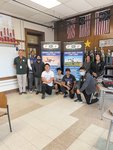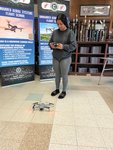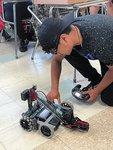By PAM SCHIFF
High schools across the state and country are constantly looking for classes and programs to increase students' interest and challenge them. Cranston East has the luck to be the …
This item is available in full to subscribers.
We have recently launched a new and improved website. To continue reading, you will need to either log into your subscriber account, or purchase a new subscription.
If you are a current print subscriber, you can set up a free website account by clicking here.
Otherwise, click here to view your options for subscribing.
Please log in to continue |
|



By PAM SCHIFF
High schools across the state and country are constantly looking for classes and programs to increase students' interest and challenge them. Cranston East has the luck to be the state’s only high school to offer a special JROTC program.
Command Sergeant Major retired US Army Moise Moniz confirmed this.
"I can tell you with 100 percent certainty that Cranston East is the only JROTC High School in Rhode Island that has an Unmanned Aircraft program," said Moniz.
The goal of the program is for cadets to learn all the required information to obtain a drone pilot license by the FAA. The Part 107 certification allows anyone with that license to operate a drone.
"These kids are ready and able to be hired," Moniz said.
In the program, cadets learn about aerodynamics and propulsions, FAA regulations, payloads and battle lines and everything involved with flying a drone. They use simulations to fly drones in the building and in the parking lot.
"For those of us in our first year in JROTC, we didn’t expect to have something like this wonderful program. It teaches us about all things drone, and an introduction to a new and upcoming field in the industry today," said freshman cadet Danny Song.
A drone license is similar to a car license where it does expire and must be renewed. The minimum age to take the test for FAA drone flying is 14; the cost is $175 for two to three years.
There are eight modules that bring cadets to the point in the curriculum where they can contact FAA to get license.
It is not an easy test. These cadets now literally have a pilot’s license to fly a drone. Four of the cadets own their own drones.
"The cadets all learned how to do videos on drones, which in turn, they may incorporate in other school activities: produce some film and photos," Moniz said.
There were a lot of nuances for cadets to learn about the drones.
"It really requires a lot of attention; it really is a hard program. To take all eight modules, learn about aerospace and drones, it's very, very challenging. There was lots of reading to do and information to take in. I’m glad I did it," said Song.
For the cadets, it took them between 20 to 30 classroom hours to get through all eight modules.
"We touched on physics, air and weather, flying and rules of FAA. Cadets took a practice test to measure their skills. Once you get used to it, it's similar to playing a video game. The true purpose is to record/film/inspect/check/measure fly and film at the same time. It is difficult to coordinate the two skills at the same time. Right is left, just like driving," said Moniz.
Moniz, himself, has completed 13 modules and has his flying license.
"I am self taught. I did it on my own time. I was motivated to do it after seeing the cadets work so hard," he said.
This was the first year the U.S. Army introduced this course at the high school level.
"It is similar to a BETA test. We are proceeding with great caution," said Moniz.
In total, there were 11 cadets who participated in the program. It was open to all LET levels, but for the most part, it was the freshmen who took the challenge.
For some of the cadets, getting involved with JROTC was an easy choice.
"My interest started at Bain. The way the Cadets carry themselves, they look very professional. I loved the way they looked, carried themselves, the opportunities and field trips. It has become a true Brotherhood/sisterhood. I was very excited that it was completely free learn about drones," said rising senior Alexis Franco.
"My brother (Jesahias Quiroa) did JROTC. From what I saw from him, the program gave him great success, and he became an honors student. I saw that the program can change a person," said Jonathan Quiroa.
The cadets all agreed that they originally thought JROTC was just sitting in a classroom and doing community service. The opportunities that JROTC has opened up for them are boundless.
"We have cadets going into STEM, robotics, we expose them to different career fields and choices," Moniz said.
"It is not what they think it is. The opportunities are provided; you need to be open and willing to take them. You need the initiative," said Franco.
Another innovative opportunity offered to the cadets is a robotics program.
"We were given a ton of parts to build a robot. We used class time to assemble the robots, then we programmed the robots with different functions. We learned how to adjust our plans. It was difficult to work in groups, and we had to learn teamwork, partnerships, patience and tolerance," said Song.
The six robots that were built were given the following names: Leonitus, after King of the Spartans, NYX, Goddess of Darkness or Moon, Kukuklan Scorpion, Wall-E from the movie, Aries and Talos protector of the Island of Crete.
The cadets also wanted to take a moment and thank Colonel (ret.) Murray for the things he taught them.
"Speaking for the whole battalion we are sad to see him leave. As a freshman, he was a huge mentor, he taught us a lot. What is the true meaning of leadership, discipline, respect not only for yourself but others. He is impossible to replace," Song said.
JROTC is open and available to any RI student entering their freshman year of high school. To learn more about JROTC at Cranston East, visit https://chsejrotc.weebly.com/information.html.
Comments
No comments on this item Please log in to comment by clicking here